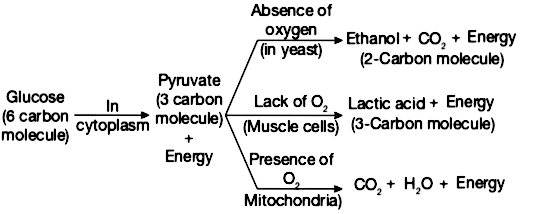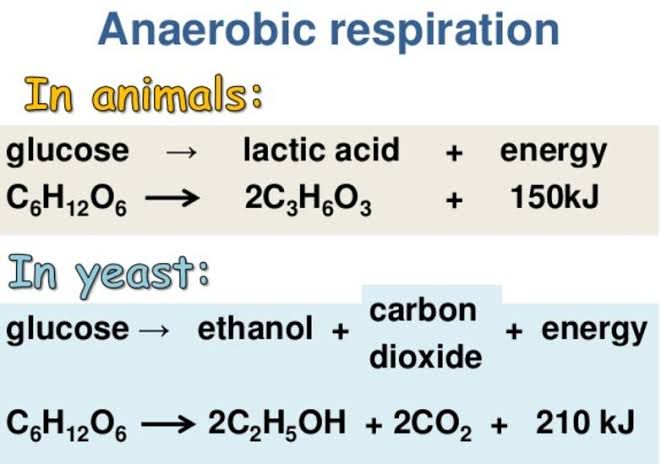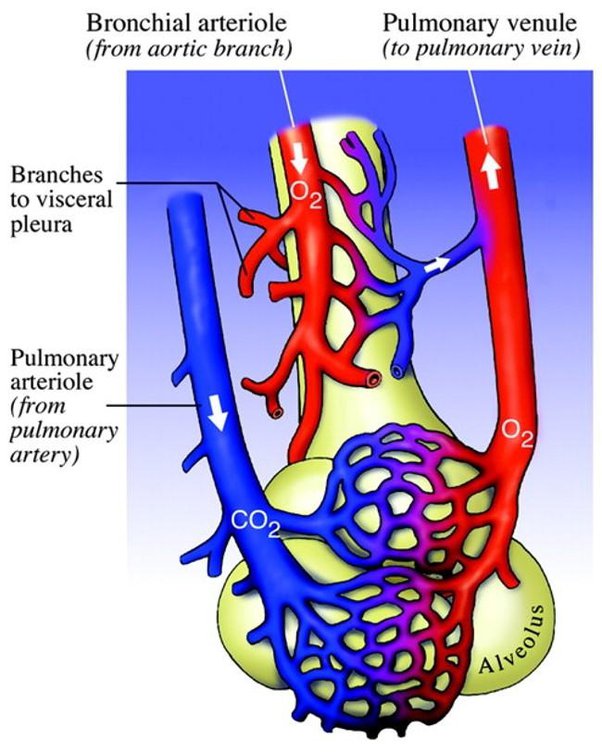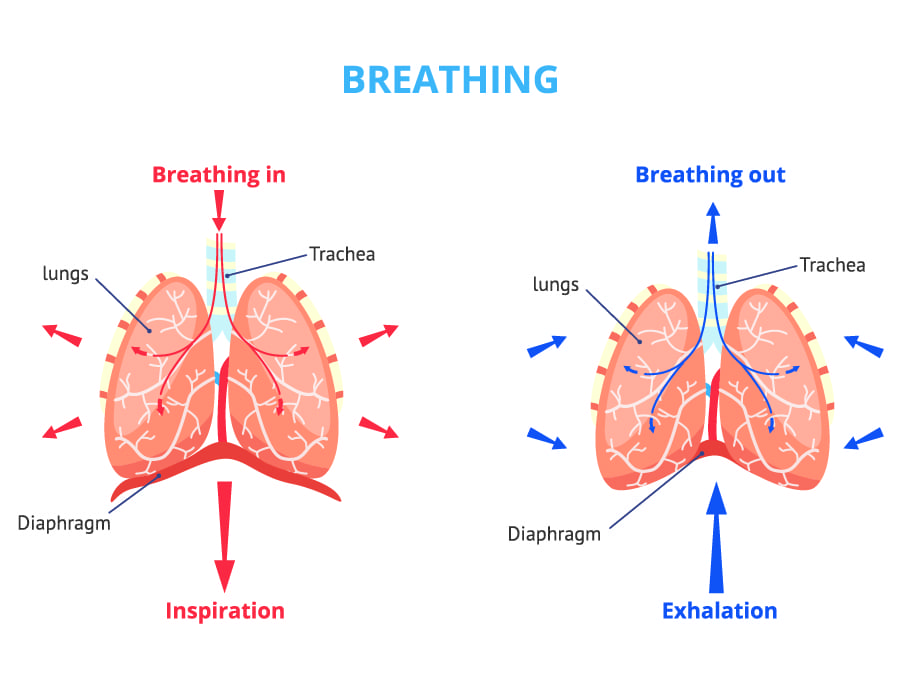What is Respiration
Respiration is the process by which food taken through the process of nutrition gets oxidized and releases energy for performing various activities.
It is the biochemical oxidation of nutrients at cellular level.
- During the process of Respiration , oxygen acquired by organisms from outside the body is used to break down the food materials to provide energy.
- It occurs in the presence of specific enzymes at optimum temperature in the cells to release energy for various metabolic activities.
- It is a catabolic process, in which exchange of gasses (viz oxygen and carbon dioxide) takes place between the body and the outside environment.
Food + Oxygen →Carbon dioxide + Water + Energy
Also Check – Importance Of Respiration
Respiratory Substrate
The organic substances undergoing oxidative breakdown during respiration are called respiratory substrates, e.g. glucose.
Types of Respiration

The biochemical oxidation of nutrients in respiration takes place in different ways in different organisms.
Some organisms use oxygen to break down glucose completely into carbon dioxide and water, while others do not require oxygen and carry it out in the absence of oxygen. Based on this criteria There are two types of respiration
Aerobic Respiration

Aerobic respiration is the complete breakdown of food in the presence of oxygen.
It releases large amount of energy in the form of ATP molecules. Read more…
Anaerobic Respiration

Anaerobic respiration is the incomplete breakdown of food occurring in the absence of oxygen, releasing a small amount of energy.
It can be alcoholic fermentation, i.e. sugar breaks into ethanol and CO₂ or lactic acid fermentation, i.e. sugar breaks into lactic acid. Read more…
Also Check – Differentiate Between Aerobic and Anaerobic Respiration
Exchange of gasses in Plants
- The energy produced in plants by respiration is utilized in growth and life functions.
- In leaves, exchange of gasses occurs through diffusion of oxygen through stomata into the cells of the leaf.
- In roots, exchange of gases occurs by diffusion from air present in soil particles to the roots.
- In stems, exchange of gases occurs through small pores present in the stems called lenticels. Read more…
Also Check –Exchange of gasses in Animals
Respiration in Human Beings
4 Major Stages of Respiration in Human Beings
In Humans there are four major stages of Respiration :
Breathing
It is a physical process in which the atmospheric air is taken in and forced out of the oxygen-absorbing organs, the lungs.
Also Check – Why Do We Get Out of Breath When We Exercise?-Explained for Kids
Gaseous Transport
The oxygen absorbed by the blood in the lungs is carried by the RBCs as oxyhaemoglobin throughout the body by means of arteries.
The carbon dioxide from the tissues is transported to the lungs by the blood by means of veins in two ways:
- As bicarbonates dissolved in plasma
- In combination with the hemoglobin of RBCs as carbamino-hemoglobin
Tissue Respiration
- Capillaries deliver the oxygen to the body cells or tissues where oxygen diffuses through their thin walls and in a similar way, the capillaries pick up the carbon dioxide released by them .
Cellular Respiration
- The complex chemical changes which occur inside the cell to release energy from glucose.
Also Check- Explain the Mechanism of Breathing in Human Beings
Human Respiratory Organs

The Important organs of human respiratory system and their functions are as follows
The Nose
- The external part of the nose bears two nostrils separated by a cartilaginous septum.
- The hairs present in the nostrils prevent large particles from entering the system.
- The two nostrils open into a pair of nasal chambers.
The inner lining of the nasal chambers performs three functions:
- It warms the air as it passes over.
- It adds moisture to the air.
- Its mucous secretion entraps harmful particles.
Also Check- Respiration in Plants
The Pharynx
- The nasal chambers open at the back into a wide cavity, the pharynx, situated at the back of the mouth.
- Pharynx is a common passage for air and food.
- It leads into an air tube, the trachea (windpipe) and a food tube (esophagus) located dorsally behind the trachea.
- When pharynx is not in use, the food tube is partially collapsed as it has soft walls.
- The entrance to the trachea is guarded by a flap called epiglottis which closes it at the time of swallowing food.
The Larynx
- The larynx or the voice-box is a hollow cartilaginous structure located at the start of the windpipe.
- The larynx contains two ligamentous folds called vocal cords.
- Air expelled forcibly through the vocal cords vibrates them producing sound.
- By adjusting the distance between the two cords and their tension by means of attached muscles, a range of sounds can be produced.
The Trachea
- The trachea or the windpipe emerges from the larynx down below in the neck where it is partly covered by the thyroid gland.
- Its walls are strengthened by C-shaped rings of cartilage, the incomplete parts of the rings being on the back side. The rings provide flexibility and keep the trachea distended permanently.
Also Check- Role of Respiratory Pigment in Respiration
The Bronchi
- Close to the lungs, the trachea divides into two tubes, called the bronchi, which enter the respective lungs.
- On entering the lungs, each bronchus divides into fine secondary bronchi, which further divide into still finer tertiary bronchi.
- The cartilaginous rings, as those present on the trachea, are also present on the smaller bronchi to keep them distended.
- Bronchioles are the subsequent still finer tubes of tertiary bronchi which acquire a diameter of about 1 mm and are without cartilage rings.
Alveoli
- By repeated branching, the bronchioles ultimately end in a cluster of tiny Air chambers called the air sacs or Alveoli.
- A network of blood capillaries surrounds the wall of each Alveolus.
- The walls of the Alveoli are extremely thin and moist, thus allowing gaseous diffusion through
- them.
- Oxygen from air first dissolves in a thin layer of water/fluid that covers the surface of alveoli.
Ciliated Epithelium
- It is the protective Inner Lining of Respiratory passage.
- The entire inner lining of the larynx, trachea, bronchi and bronchioles is formed of.
- During lifetime the cilia are constantly in motion driving any fluid (mucus) that is on them and also any particles that may have come in with the air towards the mouth.
Lungs
- The Lungs are a pair of spongy band elastic organs formed by the air sacs, their connecting bronchioles, blood vessels, etc.
- The two lungs are roughly cone-shaped, tapering at the top and broad at the bottom.
- The left lung has two lobes and the right lung has three lobes.
- The left lung is slightly smaller to accommodate the heart in between.
Membranous coverings of the lungs
- Each lung is covered by two membranes the inner (visceral) pleura and outer (parietal) pleura
- with a watery fluid (pleural fluid) in the pleural cavity found between the two membranes.
- This arrangement provides lubrication for free movement of the expanding and contracting lungs.
- The lungs occupy the greater part of the thoracic cavity.
- They are located close to the inner surface of the thoracic wall and their lower bases closely rest on the diaphragm.
Blood supply to the lungs

- The right auricle pumps all the deoxygenated blood received in it from the body into the right ventricle, which in turn, pumps it into the lungs through the main pulmonary artery.
- The pulmonary artery, soon after its emergence, divides into two branches entering their respective lungs.
- Inside the lungs, they divide and redivide several times to ultimately form capillaries around the Alveoli .
- Veins arising from these capillaries join and rejoin to form two main pulmonary veins from each lung which pour the oxygenated blood into the left auricle of the heart.

Mechanism of Gaseous Exchange In Humans

Gaseous Exchange in Humans Oxygen is absorbed via Inhalation.
Exchange of oxygen and carbon dioxide occurs between blood and alveoli.
Carbon dioxide is exhaled through lungs, i.e. exhalation and oxygen is assimilated in the body. Read more…


8 Comments on “Respiration Class 10 Notes”